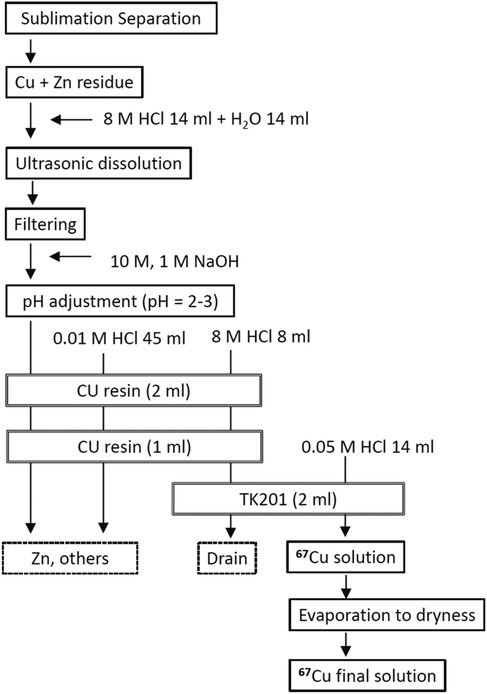- 1Oarai Research Center, Chiyoda Technol Corporation, Oarai, Japan
- 2Research Center for Accelerator and Radioisotope Science, Tohoku University, Sendai, Japan
- 3Research Center for Nuclear Physics, Osaka University, Osaka, Japan
- 4Radiation Source Production Section, Chiyoda Technol Corporation, Tokai, Japan
- 5Department of Research Infrastructure Technology Development, Japan Atomic Energy Agency, Tokai, Japan
- 6Advanced Science Research Center, Japan Atomic Energy Agency, Tokai, Japan
- 7Nuclear Science and Engineering Center, Japan Atomic Energy Agency, Tokai, Japan
- 8Research Center for Accelerator and Radioisotope Science, Tohoku University, Sendai, Japan
The 64Cu/67Cu pair is an ideal set of theranostic radionuclides for treating patients based on their genetic profiles. We propose a novel production route for this radionuclide pair using accelerator-generated neutrons. We report experimental measurements of the absolute activity and radionuclide purity of 64Cu and 67Cu, produced by irradiating 64Zn and 68Zn with these neutrons. The measured results were consistent with simulated values. 64Cu and 67Cu were separated from the irradiated natural Zn and 68Zn using sublimation and column separation techniques. The production methods for 64Cu and 67Cu developed in this study are expected to enhance their availability in an economically sustainable manner.
1 Introduction
Recently, there has been increased interest in personalized nuclear medicine. Currently, a variety of radiopharmaceuticals are administered to cancer patients for therapeutic and diagnostic purposes (1–3). These radiopharmaceuticals contain radionuclides with similar chemical and biochemical properties that allow them to target specific diseases. The term “theranostic” refers to the combined use of diagnostic and therapeutic agents containing these radionuclides (4).
When radioisotopes are used to treat cancer patients, real-time imaging is performed using pharmaceutical compounds labeled with gamma-ray-emitting diagnostic radioisotopes. This allows the distribution of pharmaceutical compounds in the patient's body to be assessed, and the appropriateness of the treatment and dosage of the therapeutic drug to be evaluated. The ability to monitor the distribution of therapeutic radioisotopes in real time enables the understanding of specific patient conditions and characteristics, and the selection of the most effective treatment through theranostics, facilitating personalized medicine (1–3).
The concept of using therapeutic and diagnostic radioisotopes in cancer treatment was first proposed in 1946 with the use of β−- and γ-emitting 131I (T1/2 = 8.0 d) for the treatment of thyroid cancer. Currently, 3.7–5.55 GBq of 131I is used for thyroid cancer treatment (3, 5). Common radioisotope pairs used for therapeutic and diagnostic purposes include 131I (123I, 124I), 90Y (111In, 86Y), 177Lu (111In), 212Pb (68Ga, 86Y), 223Ra (99mTc, 18F), 225Ac (68Ga, 86Y), 227Th (89Zr), 186Re (99mTc), and 67Cu (64Cu) (6). Diagnostic radioisotopes are indicated in parentheses.
Concurrently, the 64Cu/67Cu pair is an emerging set of radionuclides that are ideal for use in therapeutic diagnostics (theranostics) (7–11) due to their identical chemical and biological properties, the ability of copper to form diverse coordination complexes with small molecules, antibodies, and proteins, and the favorable physical properties of ⁶⁴Cu and ⁶⁷Cu (4–6). Specifically, ⁶⁴Cu has a half-life of 12.7 h and decays via positron emission (17.5%) with a maximum energy of 0.653 MeV, β−-rays emission (38.5%) with a maximum energy of 0.579 MeV, and electron capture (44.0%) (12, 13) as shown in Figure 1A, making it suitable for positron emission tomography (PET). ⁶⁷Cu has a half-life of 61.8 h and emits β−-rays with maximum energies of 0.377 MeV (57%), 0.468 MeV (22%), and 0.562 MeV (20%) (13, 14), as illustrated in Figure 1B. These β−-rays have a range of approximately 3 mm in water (15). Furthermore, ⁶⁷Cu emits 91, 93, and 185 keV γ-rays, enabling its detection by gamma cameras. Consequently, 67Cu is well-suited for diagnostic imaging and internal radiotherapy. Therefore, increasing Cu availability is crucial for the development of radiopharmaceuticals that target various diseases (6–8).
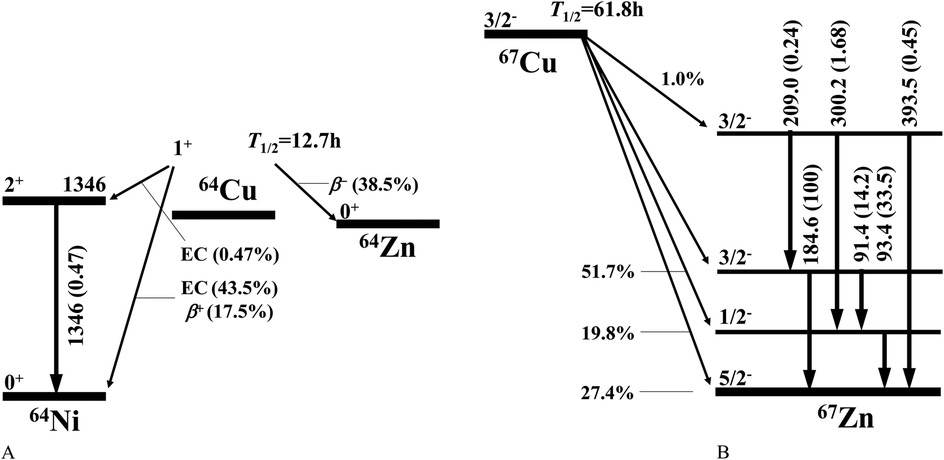
Figure 1. Decay schemes of 64Cu (A) and 67Cu (B), reproduced from references (12) and (14), respectively.
Numerous studies have been on the production of ⁶⁷Cu using the ⁶⁷Zn(n,p)⁶⁷Cu reaction in reactors (16). Additionally, studies have been conducted on the production of ⁶⁷Cu using the ⁶⁸Zn(p,2p)⁶⁷Cu (16, 17), ⁶⁸Zn(γ,p)⁶⁷Cu (18, 19), ⁶⁷Zn(n,p)⁶⁷Cu (20), ⁷⁰Zn(p,α)⁶⁷Cu (16, 21), and ⁷⁰Zn(d,αn)⁶⁷Cu (22) reactions in accelerators. Recently, a significant improvement in the accessibility of ⁶⁷Cu was achieved using the ⁶⁸Zn(γ,p)⁶⁷Cu reaction at the Argonne National Laboratory Low Energy Accelerator Facility (9). This resulted in a production yield of over 62.9 GBq after 53.5 h of irradiation.
64Cu has also been produced in reactors by the 63Cu(n,γ)64Cu reaction and in accelerators by the 64Ni(p,n)64Cu, 64Ni(d,2n)64Cu, 64Zn(d,2p)64Cu, 66Zn(d,α)64Cu, 68Zn(p,αn)64Cu, and 64Zn(n,p)64Cu reactions. The most commonly adopted production route is 64Ni(p,n)64Cu (23). Indeed, the production of high-quality 64Cu with 8.7 GBq at EOI was achieved by bombarding a highly enriched 64Ni target (enrichment 99.53%) with a 20 μA proton beam for a period of 4 h (24).
Kin et al. previously proposed a novel route for producing 67Cu and 64Cu using accelerator neutrons with energies ranging from a few MeV to approximately 40 MeV via the 68Zn(n,n'p)67Cu and 68Zn(n,d)67Cu reactions, as well as the 64Zn(n,p)64Cu reaction (15), based on the following results obtained by them: Kin et al. measured the activation cross-sections of 64Cu and 67Cu by bombarding natural zinc with 14 MeV neutrons. The production yields of 64Cu and 67Cu by accelerator neutrons from natC(d,n) with 40 MeV 5 mA deuterons were estimated using the results and the evaluated cross-sections of the Zn isotopes. The estimated 64Cu yield was 1.8 TBq (175 g 64Zn) after 12 h of irradiation. At the end of the two-day irradiation period, the estimated yield of 67Cu from 67Zn(n,p)67Cu was 249 GBq (184 g 67Zn), and the estimated yield from 68Zn(n,n'p)67Cu and 68Zn(n,d)67Cu were 287 GBq (186 g 68Zn).
Subsequently, production yield studies of 67Cu and 64Cu were conducted (25–28), and an apparatus for the separation and purification of these radionuclides from neutron-irradiated ZnO was constructed. Kawabata et al. initially established a fundamental separation and purification procedure, using only the column separation technique for 64Cu and 67Cu from neutron-irradiated natZnO and 64ZnO 5 g with high separation efficiency and successful labelling, together with high recovery of Zn samples. The column separation technique was employed in the determination of the biodistribution of 67CuCl2 in colorectal tumor-bearing mice by Sugo, Hashimoto, Kawabata et al. (26). In the latest study, Kawabata et al. developed a combined thermal and column chromatography separation to separate 64Cu and 67Cu from 55.4 g of natural zinc that had been irradiated with accelerator neutrons. Sublimation removed 99% of the zinc, with 97% physically recovered for reuse. Following the removal of most of the zinc by thermal separation, the residual zinc containing 67Cu was in the order of milligrams. The residual zinc was further purified using chromatographic resins (28, 29). The experiments yielded a total separation efficiency of 73% for 67Cu.
In this study, we measured the absolute activity and radionuclidic purity of 64Cu and 67Cu produced by neutron irradiation of 64ZnO and 68ZnO. The measured values of 64Cu and 67Cu were compared with the simulation results. In addition, new sublimation and column separation apparatuses were installed at the Research Center for Accelerator and Radioisotope Science (RARiS) facility at Tohoku University.
2 Materials and methods
The schematic diagram for the production and separation of 64Cu and 67Cu from neutron-irradiated 64Zn and 68Zn is shown in Figure 2.
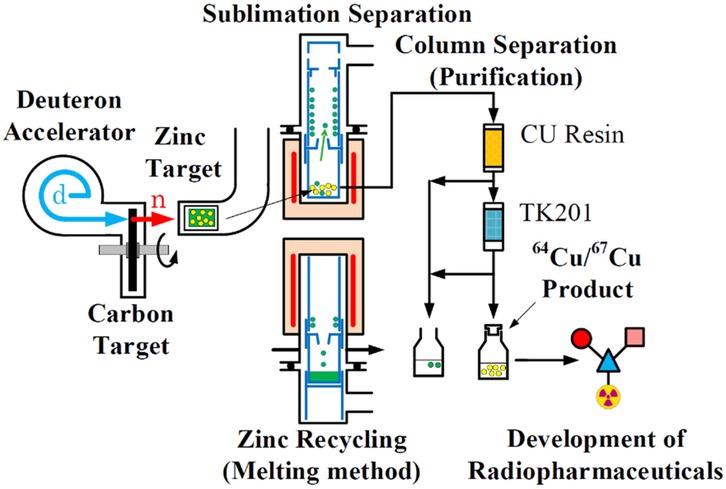
Figure 2. Schematic diagram of 67Cu and 64Cu production using accelerator neutrons generated by deuterons, and their subsequent separation from 68Zn and 64Zn. The accelerator neutrons were produced via the natC(d,n) reaction in a vacuum. The natC target was placed in a vacuum chamber and equipped with a rotating cooling system to manage the thermal load associated with high-intensity deuteron beams.
2.1 Production of 67Cu and 64Cu
Copper−64 and Copper-67 were produced by irradiating enriched samples of ⁶⁴Zn and ⁶⁸Zn with accelerator neutrons through the reactions ⁶⁴Zn(n,p)⁶⁴Cu, ⁶⁸Zn(n,n’p)⁶⁷Cu, and ⁶⁸Zn(n,d)⁶⁷Cu. Accelerator neutrons were generated via the natC(d,n) reaction. The natural carbon target (natC), with a thickness of 10 mm and a diameter of 27 mm, was placed within a deuteron beam duct (vacuum). The samples, consisting of 0.295 g 64ZnO and 0.363 g 68ZnO, each with a diameter of 10 mm, were placed in air at 0° with respect to the deuteron beam direction. Prior to irradiation, the samples were pressed into pellets and sintered at 150°C for 40 min. The isotopic composition of the 64Zn sample was 99.935% and that of the 68Zn sample was: 64Zn (0.03 at%), 66Zn (0.16 at%), 67Zn (0.62 at%), 68Zn (99.16 at%), and 70Zn (0.03 at%). Niobium foils, 10 mm in diameter and 0.1 mm thick, were positioned on either side of the 64ZnO and 68ZnO pellets to monitor the neutron yield. A typical description of the experimental setup for irradiation of Zn samples is given in (28).
Copper-64 was produced by irradiating 64ZnO with neutrons for three hours. Neutrons were generated using 41 MeV deuterons with an average beam current of 0.11 μA, provided by the AVF cyclotron at the Takasaki Ion Accelerator Advanced Radiation Applications Facility (TIARA), National Institutes for Quantum and Radiological Science and Technology (30). Copper-67 was produced by irradiating 68ZnO with neutrons for three minutes. Neutrons were generated using 52 MeV deuterons with an average beam current of 0.379 μA, provided by the AVF cyclotron at RARiS, Tohoku University (31). The 52 MeV deuteron beam is the highest energy currently achievable with these AVF cyclotrons.
The absolute activity and radionuclide purity of ⁶⁴Cu and ⁶⁷Cu were, respectively, determined by measuring the 1,346 keV γ-ray intensity from the decay of ⁶⁴Cu and the 185 keV γ-ray intensity from the decay of ⁶7Cu. The absolute activity of ⁶⁴Cu and ⁶⁷Cu depends on the excitation function for the reaction of ⁶⁴Zn(n,p)⁶⁴Cu and ⁶⁸Zn(n,n’p)⁶⁷Cu and the ⁶⁸Zn(n,d)⁶⁷Cu. The excitation functions evaluated for reactions such as 64Zn(n,p)64Cu, 64Zn(n,n’p)63Cu, and 64Zn(n,d)63Cu are shown in Figure 3A, and those evaluated for reactions such as 68Zn(n,n'p)67Cu, 68Zn(n,d)67Cu, and 68Zn(n,4n)65Zn are shown in Figure 3B. These figures highlight the importance of measuring the yields and radionuclide purities of 64Cu and 67Cu over a range of neutron (or deuteron) energies.
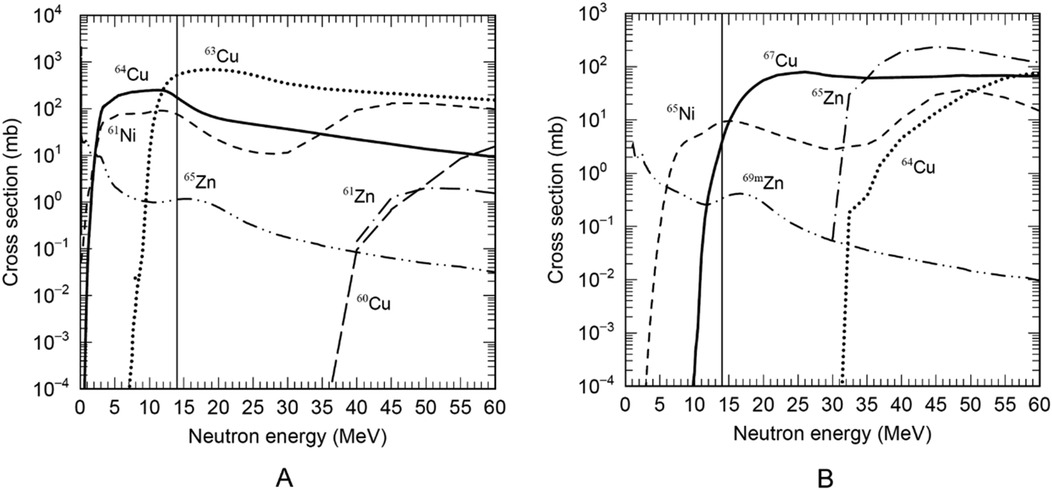
Figure 3. (A) evaluated excitation functions for reactions such as 64Zn(n,p)64Cu, 64Zn(n,n’p)63Cu, and 64Zn(n,d)63Cu during neutron irradiation of enriched 64Zn (32). (B) Evaluated excitation functions for reactions including 68Zn(n,n′p)67Cu, 68Zn(n,d)67Cu, and 68Zn(n,4n)65Zn during neutron irradiation of enriched 68Zn (32). 65Ni (T1/2 = 2.5 h) and 65Zn (T1/2 = 244 d) decay to 65Cu (a stable nuclide), while 69mZn (T1/2 = 14 h) decays to 69Ga (also stable). The excitation functions for the 68Zn(n,n′p)67Cu, 68Zn(n,d)67Cu, and 64Zn(n,p)64Cu reactions indicate very low production of Zn-based impurity radionuclides. The most probable 14 MeV neutron energy generated by the natC(d,n) reaction using 40 MeV deuterons is indicated by the thin solid line (33).
The accelerator neutrons used to produce 64Cu and 67Cu exhibited the following characteristics. First, a neutron energy spectrum can be obtained from the C(d,n) reaction, which is suitable for the efficient production of these radionuclides, by appropriately selecting the deuteron energy (Ein) (27, 28). Second, neutrons are predominantly emitted in the forward direction relative to the deuteron beam axis (34–36), resulting in nearly complete irradiation of the enriched 64Cu or 68Zn placed immediately behind the natC target (36). Notably, SPIRAL2 at GANIL in France will produce 101⁵ neutrons per second (n/s) through the natC(d,n) reaction using 40 MeV, 5 mA deuterons (33).
2.1.1 Absolute activity and radionuclide purity of 64Cu and 67Cu
The measured absolute activities and radionuclide purities of 64Cu and 67Cu were compared with the evaluated values, as follows:
First, we note that a single radionuclide, B, is produced via a neutron-induced reaction on the Zn isotope A in the enriched 64Zn or 68Zn samples. This is represented by the A(n,x)B reaction. Next, the yield rate Ya of radionuclide B produced from isotope A via a reaction channel, α ≡ α(A, B), of the A(n,x)B reaction was derived as:
where σα(En) is the excitation function at neutron energy En for the channel α, and fn(En) is the neutron fluence in the sample. In Equation 1, the limits Emin and Emax correspond to the energy range of the neutrons produced by the natC(d,n) reaction in a 10-mm-thick carbon target. Note that Emin should be set to the threshold energy for channel α if Emin is lower than this threshold. Excitation functions σα(En) were obtained from the production cross sections provided in the fifth version of the Japanese Evaluated Nuclear Data Library (JENDL-5) (37). The neutron fluence fn(En) was derived from a particle transport simulation using the Particle and Heavy Ion Transport code System (PHITS) (38), which accounted for neutron propagation from the carbon target—where neutrons are produced with energy and angle via the natC(d,n) reaction—to the Zn sample. The fluence of the produced neutrons at position r in the target is given by:
where is the number of carbon nuclei in the target, and 52 MeV are the incident deuteron energies, are the neutron production cross sections obtained from JENDL-5, and is the deuteron fluence at position r, normalized per incident deuteron. The PHITS simulation accounted for the attenuation of deuteron fluence in the target, including the corresponding decrease in deuteron energy. The neutron fluence in the Zn sample was calculated as the component of directed toward the sample. By setting the number of deuterons Nd irradiating the sample, isotopic abundance RA of isotope A in the Zn sample, and particle density ρ of Zn, the total yield Y(B) of radionuclide B in the sample can be expressed as:
where indicates that the summation includes all reaction channels α through which isotope A can produce radionuclide B. Here, A refers to one of the five stable Zn isotopes: 64Zn, 66Zn, 67Zn, 68Zn, and 70Zn, and B denotes one of Cu or Zn radionuclides listed in Reference (39). Furthermore, Ga radionuclides were evaluated as products B by replacing neutrons with protons in the above equations. Finally, the yield was multiplied by the saturation factor to evaluate the amount produced at the EOI. Stable isotopes of 63Cu and 65Cu can be produced by reactions such as 64Zn(n,n'p)63Cu and 68Zn(n,p3n)65Cu, respectively. Their production reduced the specific activity of the products 64Cu and 67Cu. Consequently, an absolute yield evaluation of these isotopes is imperative, because they are not detectable by radiation detectors.
2.2 Separation of 67Cu and 64Zn from irradiated 68Zn and natZn
We developed a new sublimation and column chromatography separation apparatus to be installed in an existing hot cell at the Research Center for Accelerator and Radioisotope Science (RARiS) facility at Tohoku University. The apparatus was designed for the production and separation/purification of 64Cu and 67Cu using the cyclotron at Tohoku University. To obtain 67Cu and 64Cu from irradiated 68Zn and natZn, respectively, the same separation apparatus was used for both sublimation and column chromatography because both irradiated samples contained common impurity radionuclides belonging to Cu and Zn in addition to the desired 67Cu and 64Cu.
2.2.1 Sublimation separation of Zn
The initial separation of 67Cu (or 64Cu) in the milligram range from neutron-irradiated bulk 68Zn (or natZn) was achieved using the sublimation method, originally developed by the Argonne National Laboratory (ANL) group (40). We developed a vertical-type sublimation apparatus (Figure 4) instead of the horizontal-type due to the inadequate effective dimensions within the cell.
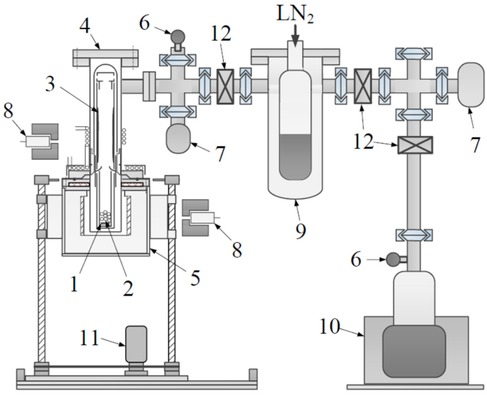
Figure 4. Layout of the sublimation separation apparatus for an irradiated Zn sample. (1) Irradiated Zn sample containing 67Cu activity, (2) quartz beads, (3) sublimated Zn element, (4) vacuum chamber, (5) electric tubular furnace, (6) electric leak valve, (7) vacuum gauge, (8) CZT γ-ray detector, (9) cold trap, (10) turbomolecular pump, (11) motor, (12) butterfly valve.
Cooling devices were attached to the upper flange and top of the vacuum vessel to facilitate the recovery of sublimated Zn inside the system. Sublimation is an effective method for the separation of Zn and Cu due to the substantial difference in their boiling points: The boiling points of Zn and Cu are 907°C and 2,562°C, respectively. In this study, sublimation experiments were performed at temperatures of 500 and 600°C under a vacuum of 2.0 × 10−5 hectopascal (hPa) to determine the optimal temperature for maximizing Zn sublimation while reducing the amount of distilled Cu. This apparatus can separate more than 40 g of Zn via thermal separation.
The furnace temperature can be controlled remotely, and the separation vessel can be raised or lowered remotely outside the cell. Two 67Cu activities were produced by irradiating 43.6 g of natZn, consisting of three pellets, with accelerator neutrons, and bombarding an enriched 68Zn pellet (3.93 g) with photons. Accelerator neutrons and photons were generated by a cyclotron and an electron linear accelerator (linac), respectively, at Tohoku University. The irradiated Zn samples were placed in a quartz tube with quartz beads (7 mm ϕ), which were dispersed between the pellets to serve as fillers and increase the sublimation surface among samples comprising more than 10 g of multiple pellets to increase the sublimation surface area of the Zn and shorten the sublimation time (28). γ-ray spectra were recorded every 3 min using a CZT detector while heating, in order to monitor changes in the activity of 67Cu (185 keV) and 65Zn (1,116 keV) over time. After heating was stopped, the furnace was lowered to allow the system to cool below 200°C, after which the equipment was returned to atmospheric pressure. The quartz components were then removed and weighed to determine the Zn deposition and sublimation efficiency.
The efficiency of sublimation separation of irradiated Zn was determined online by comparing the activity of ⁶⁵Zn (1,116 keV γ-ray) measured with the CZT detector before and after separation. The Zn accumulated in the quartz tube during the sublimation of Cu from the irradiated Zn was collected for recycling. Prior to collection, the distribution of accumulated Zn was determined by measuring the 65Zn (1,116 keV) signal using a high-purity germanium (HPGe) detector. The separation yield of Zn was calculated using a gravimetric method.
The non-radioactive Cu present in the Zn sample was removed prior to irradiation, because it lowers the specific activity of the 64Cu or 67Cu product (28). The zinc samples were sublimated at 650°C for 120 min under vacuum to prevent oxidation. The sublimated zinc was subsequently collected, melted, and prepared as pellets for irradiation. This method can also be applied to the recycling of enriched zinc after the separation of 67Cu (64Cu).
The copper remaining in the test tube was further purified using commercially available resins, as described below.
2.2.2 Purification of 67Cu by column chromatography
The purification scheme is illustrated in Figure 5. Two CU Resin cartridges (2 ml and 1 ml, TrisKem International) and one TK201 cartridge (2 ml, TrisKem International) were pre-conditioned with 30 ml of 0.01 M HCl (15 ml for the 1 ml resin) and 30 ml of 8 M hydrochloric acid, respectively. A 1 ml CU Resin cartridge was placed below the 2 ml cartridge as a guard column to retain any copper that may have leaked from the larger cartridge. After the sublimation of bulk Zn, quartz beads were added to the test tube to fill the void space, and 8 M hydrochloric acid was added until the tube opening was submerged, —typically requiring approximately 15 ml, —to ensure the complete dissolution of the copper and Zn residues. Dissolution was enhanced by applying ultrasonic waves for 10 min. The solution containing dissolved Cu and Zn was transferred to another container. The test tubes were washed with ultrapure water under ultrasonic agitation for 10 min. The resulting solution was filtered through a glass filter to remove insoluble residues and ash. The pH of the filtrate was adjusted to pH 2–3 using a NaOH solution.
This pH-adjusted solution was loaded onto the CU Resin cartridge to adsorb 67Cu, followed by washing with 45 ml of 0.01 M HCl to remove residual Zn and other impurities. The flow rate was maintained at 1.0 ml/min, controlled by a peristaltic pump. After trapping copper in the CU Resin, 8 ml of 8 M HCl was passed through the column to elute 67Cu, which was then reabsorbed onto the TK201 resin. The final 67Cu product was eluted with 14 ml of 0.05 M HCl, followed by acid removal through evaporation. The same purification procedure was use to separate 64Cu from 64Zn.
The total time required for sublimation and chromatography steps was 8 h, each step requiring 4 h.
3 Results
We discuss these results by referring to the γ-ray branching ratios obtained from the decay of 67Cu, as shown in Figure 1A.
3.1 Absolute activity and radionuclide purity of 64Cu and 67Cu
Figure 6 shows the γ-ray spectrum of irradiated 68Zn. The observed γ-ray peaks originate from the decay of 67Cu (91, 93, 185, 209, 300, and 394 keV), 65Ni (T1/2 = 2.52 h; 366, 508, 610, and 1,116 keV), 65Zn (T1/2 = 244 d; 1,116 keV), and 69mZn (T1/2 = 13.8 h; 439 keV). The isotope assignments of the observed γ-rays were based on their energies, decay curves, and known branching ratios.
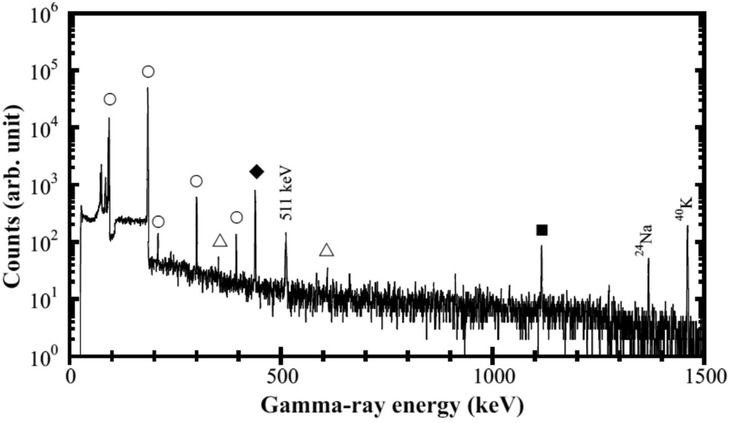
Figure 6. γ-ray spectrum of the neutron irradiated 68ZnO using a deuteron beam of 52 MeV. The γ-ray peaks originate from the decays of 67Cu (open circles), 65Ni (open triangles), 69mZn (filled diamond), and 65Zn (filled square).
The activity of 67Cu and the impurity of 65Zn (as well as 64Cu and the impurities of 61Cu, 62Zn, and 63Zn) at EOI were determined by considering the branching ratios of the observed 185 keV and 1,116 keV (and 1,346 keV and 656 keV, 597 keV, and 670 keV) γ-rays (41), as well as the γ-ray detection efficiency of the HPGe detector, which was calibrated using a standard 152Eu γ-ray source. The self-absorption of the γ-rays in the irradiated 68Zn sample was corrected using the photon cross-sectional database provided by the National Institute of Standards and Technology (42). The calculated yields of 67Cu and 65Zn (along with 64Cu, 61Cu, 62Zn, and 63Zn) at EOI, obtained using the radionuclide production rates, irradiation time, and deuteron beam intensity, are presented in Table 1. The calculated and measured yields were in good agreement within an uncertainty of ±20%. The total systematic uncertainty in the calculated yields was estimated to be 23%, taking into account the uncertainty of 18% in the measured neutron data for the natC(d,n) reaction (43), and an assumed 15% uncertainty in the evaluated cross sections. The total systematic uncertainty in the experimental values was calculated to be 12%, based on the estimated uncertainties in the distance between the carbon target and the sample, spatial distribution of the deuteron beam intensity and diameter, and γ-ray detection efficiency of the HPGe detector.

Table 1. The measured and calculated activities of 67Cu, 64Cu, 65Zn, 69mZn, 65Ni, 66Ga, and 67Ga at the EOI of enriched 68Zn at Ein = 52 and 40 MeV are shown.
The measured activity of 67Cu at Ein = 52 MeV at EOI was 1.23 ± 0.05 kBq, which was approximately 3.2 times higher than 0.383 ± 0.02 kBq measured at Ein = 40 MeV. In contrast, the measured yield of 65Zn at 52 MeV was 2.9 ± 0.16 Bq, which was approximately 12 times higher than 0.25 ± 0.02 Bq, measured at 40 MeV. The substantial increase in 67Cu yield observed when employing 52 MeV deuteron beams underscores the practical advantage of expanding the availability of 67Cu, 65Zn was separated from 67Cu via sublimation.
Figure 7 shows the gamma-ray spectrum of irradiated 64Zn. The observed gamma-ray peaks originate from the decay of 64Cu (511 and 1346 keV), 61Cu (T1/2 = 3.32 h, 656 keV), 62Zn (T1/2 = 9.26 h, 548.4 and 596.6 keV) 63Zn (T1/2 = 38.5 minutes. 669.6 and 962.1 keV). The measured activities of 64Cu, 61Cu, 62Zn, and 63Zn at Ein = 41 MeV at the EOI were 6.61 ± 0.42 kBq, 59.4 ± 4.7 Bq, 214 ± 12 Bq, and 39.5 ± 3.6 kBq, respectively, as listed in Table 2. 64Cu produced the low amount level of 61Cu radioactive waste. Copper-61 is produced by the 64Zn(n,p3n)61Cu reaction. Short lived impurity radionuclide 62Zn and 63Zn can be separated by sublimation process.
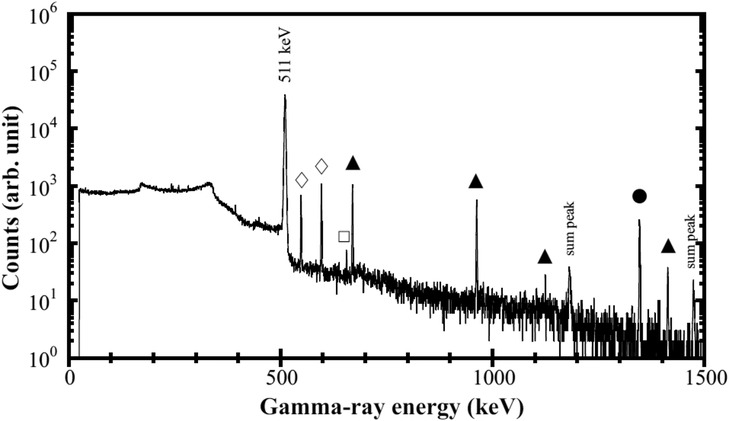
Figure 7. γ-ray spectrum of the neutron irradiated 64ZnO using a deuteron beam of 41 MeV. The γ-ray peaks come from the decays of 64Cu (filled circle), 61Cu (open square), 62Zn (filled tringle), and 63Zn (open diamond).

Table 2. The measured and calculated activities of 64Cu, 61Cu, 62Zn, 63Zn, and 65Zn at the EOI of enriched 64Zn at Ein = 41 MeV are shown, along with the ratio of calculated numbers of atoms for non-radioactive 63Cu and 65Cu relative to 64Cu.
3.2 Separation
Figure 8 shows the γ-ray spectrum measured after the purification of the neutron irradiated natZnO. The γ-ray peaks come from the decays of 64Cu and 67Cu. A 65Zn radionuclide impurity in the final 64Cu product was below the detection limit of gamma-ray spectrometry providing 65Zn/64Cu\0.01%.
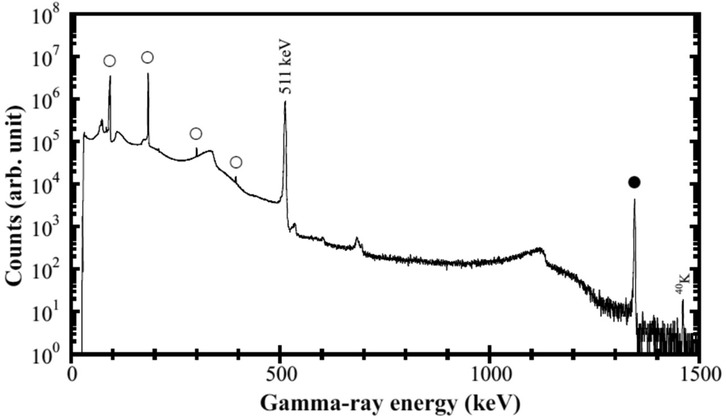
Figure 8. γ-ray spectrum measured after the purification of the neutron irradiated natZnO using a deuteron beam of 40 MeV. The γ-ray peaks come from the decays of 64Cu (filled circle) and 67Cu (open circle).
The Zn separation yield was determined using a gravimetric method. Using this apparatus, thermal separation was performed on 43.6 g of irradiated natural zinc, achieving a sublimation rate of 99% and recovering 94% of the zinc in a reusable form. At the end of the thermal separation process, the Cu-67 yield reached 87%, and subsequent chemical purification resulted in an overall Cu-67 recovery yield of 79%. For 3.932 g of enriched 68Zn, the separation efficiency was 99% by sublimation and 95% by column chromatography, with a total separation efficiency of 94%. The sublimation time for natZn was 93 min, whereas that for 68Zn was 20 min. In both samples, the amount of 67Cu remaining in the non-sublimated material was less than 50 mg, which enabled subsequent purification by chromatography.
4 Discussion
The 64Cu/67Cu pair is an emerging set of radionuclides for use in theragnostic due to their identical chemical and biological properties and their favorable physical properties. Therefore, increasing the availability of ⁶⁷Cu and ⁶⁴Cu is crucial for developing radiopharmaceuticals that target various diseases. The novel production method of both 67Cu and 64Cu using accelerator neutrons provided from accelerators was previously proposed.
The absolute activity and radionuclidic purity of 64Cu and those of 67Cu were measured for the first time using enriched 64ZnO and 68ZnO at a deuteron energy of 41 MeV and 52 MeV, respectively. High radionuclidic purity of 64Cu was produced with a minimum level of radioactive waste. The 67Cu activity at 52 MeV was found to be 3.2 times higher than that at 40 MeV. The measured radioactivity and radionuclidic purity of 64Cu and 67Cu were in good agreement with the simulation based calculated values. The simulation further estimated the unmeasured yields of non-radioactive 63Cu and 65Cu relative to 64Cu and 67Cu at 41 MeV and 52 MeV, respectively. This information provides valuable insight into the specific activity of 64Cu and 67Cu.
Using the new apparatus, thermal separation was performed on 43.6 g of irradiated natZn, achieving a sublimation efficiency (rate) of 99% and recovering 94% of the zinc in a reusable form. At the end of the thermal separation process, the 67Cu yield reached 87%, and subsequent chemical purification resulted in an overall 67Cu recovery yield of 79%. Separation experiments for 64Cu and 67Cu were conducted using neutron irradiated natZn of 43.6 g and enriched 68Zn of 3.932 g. The sublimation temperature for the irradiated Zn was adjusted to 600°C and 500°C to enhance the Zn sublimation yield while minimizing the co-distillation of copper. Gamma-ray spectrum measured after the purification of the natZnO show the dominant γ-ray peaks from the decays of 64Cu and 67Cu.
The present study demonstrates the fundamental steps for large-scale production of 64Cu and 67Cu. Deuteron beam intensity of 40 MeV used in this study was approximately 5 μA, 0.1% of 5 mA 40 MeV. As a result of this work, a new project aimed at accelerating 25–40 MeV, 100 µA (20 times the current intensity) deuterons using the existing cyclotron at RARiS, Tohoku University, has been approved (44). This capability is expected to be achieved in the near future.
5 Conclusion
The radionuclide pair 64Cu and 67Cu is considered an ideal theranostic candidate due to its identical chemical properties, the versatile coordination chemistry of copper, and suitable physical characteristics. Accordingly, radiopharmaceuticals based on 64Cu and 67Cu are expected to play a key role in the theranostic treatment of various diseases.
A novel method for producing 64Cu and 67Cu pairs using accelerator neutrons has demonstrated excellent results, enabling the separation and purification of high-quality 64Cu and 67Cu pairs using the same separation apparatus by sublimation and column chromatography-based separation of 64Cu and 67Cu from irradiated 64Zn and 68Zn. The central objective of the newly approved project is to strengthen ongoing research into the domestic production of radiopharmaceuticals containing 64Cu and 67Cu.
Data availability statement
The raw data supporting the conclusions of this article will be made available by the authors, without undue reservation.
Author contributions
YN: Writing – review & editing, Investigation, Writing – original draft, Data curation. MK: Writing – original draft, Investigation, Data curation. HS: Methodology, Data curation, Writing – review & editing. SM: Writing – review & editing, Formal analysis, Methodology, Investigation. KH: Writing – review & editing, Methodology, Investigation. KT: Formal analysis, Data curation, Investigation, Writing – review & editing. AM: Writing – review & editing, Investigation, Methodology. AO: Writing – review & editing, Investigation, Formal analysis. NT: Formal analysis, Writing – review & editing, Investigation. SH: Writing – review & editing, Formal analysis, Writing – original draft, Investigation. MI: Methodology, Investigation, Writing – review & editing. HK: Investigation, Writing – review & editing, Methodology. SF: Writing – review & editing, Conceptualization, Investigation.
Funding
The author(s) declare that financial support was received for the research and/or publication of this article. The present work was supported in part by JSPS KAKENHI Grant Numbers JP19K03903, JP21H03742, JP22K03662, JP23K21830 and in part by Program on Open Innovation Platform with Enterprises, Research Institute and Academia, Japan Science and Technology Agency (JST, OPERA, JPMJOP1721).
Acknowledgments
We thank Kawauchi, Y. and Iwamoto, N. for useful discussions, Watabe, H., Koguchi, Y. for their continuous supports, and the CYRIC cyclotron and electron linac at RARiS at Tohoku University, and the TIARA operating crew in ensuring reliable operation of the instrument.
Conflict of interest
All authors declare that the research was conducted in the absence of any commercial or financial relationships that could be construed as potential conflicts of interest.
The author(s) declared that they were an editorial board member of Frontiers, at the time of submission. This had no impact on the peer review process and the final decision.
Generative AI statement
The author(s) declare that no Generative AI was used in the creation of this manuscript.
Any alternative text (alt text) provided alongside figures in this article has been generated by Frontiers with the support of artificial intelligence and reasonable efforts have been made to ensure accuracy, including review by the authors wherever possible. If you identify any issues, please contact us.
Publisher's note
All claims expressed in this article are solely those of the authors and do not necessarily represent those of their affiliated organizations, or those of the publisher, the editors and the reviewers. Any product that may be evaluated in this article, or claim that may be made by its manufacturer, is not guaranteed or endorsed by the publisher.
References
1. Srivastava SC, Mausner LF. Therapeutic radionuclides: production, physical characteristics, and applications. In: Baum RP, editor. Therapeutic Nuclear Medicine. Berlin, Heidelberg: Springer Berlin Heidelberg (2013). p. 11–50.
2. Cutler CS, Hennkens HM, Sisay N, Huclier-Markai S, Jurisson SS. Radiometals for combined imaging and therapy. Chem. Rev. (2013) 113(2):858–83. doi: 10.1021/cr3003104
3. Ballinger JR. Theranostic radiopharmaceuticals: established agents in current use. Brit J Radiol. (2018) 91(1091):20170969. doi: 10.1259/bjr.20170969
5. Seidlin SM, Marinelli LD, Oshry E. Radioactive iodine therapy: effect on functioning metastases of adenocarcinoma of the thyroid. J Am Med Assoc. (1946) 132(14):838–47. doi: 10.1001/jama.1946.02870490016004
6. Koziorowski J, Ballinger J. Theragnostic radionuclides: a clinical perspective. Q J Nucl Med Mol Imaging. (2021) 65(4):306–14. doi: 10.23736/S1824-4785.21.03424-5
7. Smith NA, Bowers DL, Ehst DA. The production, separation, and use of 67Cu for radioimmunotherapy: a review. Appl Radiat Isot. (2012) 70:2377–83. doi: 10.1016/j.apradiso.2012.07.009
8. Novak-Hofer I, Schubiger A. Copper-67 as a therapeutic nuclide for radioimmunotherapy. Eur J Nucl Med Mol Imaging. (2002) 29:821–30. doi: 10.1007/s00259-001-0724-y
9. Merrick MJ, Rotsch DA, Tiwari A, Nolen J, Brossard T, Song J, et al. Imaging and dosimetric characteristics of 67Cu. Phys Med Biol. (2021) 66:035002. doi: 10.1088/1361-6560/abca52
10. Keinänen O, Fung K, Brennan JM, Zia N, Harris M, Van Dam E, et al. Harnessing 64Cu/67Cu for a theranostic approach to pretargeted radioimmunotherapy. Proc Natl Acad Sci. (2020) 117:28316. doi: 10.1073/pnas.2009960117
11. Hussain M, Qaim SM, Spahn I, Aslam MN, Neumaier B. Copper radionuclides for theranostic applications: towards standardisation of their nuclear data. A mini-review. Front Chem. (2023) 11:1270351. doi: 10.3389/fchem.2023.1270351
12. Bé MM, Cassette P, Lépy MC, Amiot MN, Kossert K, Nähle OJ, et al. Standardization, decay data measurements and evaluation of 64Cu. Appl Radiat Isot. (2012) 70(9):1894–9. doi: 10.1016/j.apradiso.2012.02.056
13. Capote R, Nichols AL, Nortier FM, Carlson BV, Engle JW, Hermanne A, et al. IAEA coordinated research project on nuclear data for charged-particle monitor reactions and medical isotope production. EPJ Web Conf. (2017) 146:08007. doi: 10.1051/epjconf/201714608007
14. Chen J, Kondev FG, Ahmad I, Carpenter MP, Greene JP, Janssens RVF, et al. Precise absolute γ-ray and β-decay branching intensities in the decay of 6729Cu. Phys Rev C. (2015) 92(4):044330. doi: 10.1103/PhysRevC.92.044330
15. Kin T, Nagai Y, Iwamoto N, Minato F, Iwamoto O, Hatsukawa Y, et al. New production routes for medical isotopes 64Cu and 67Cu using accelerator neutrons. J Phys Soc Jpn. (2013) 82(3):034201. doi: 10.7566/JPSJ.82.034201
16. Mirzadeh S, Mausner LF, Srivastava SC. Production of no-carrier added 67Cu. Appl Radiat Isot. (1986) 37:29–36. doi: 10.1016/0883-2889(86)90192-9
17. Medvedev DG, Mausner LF, Meinken GE, Kurczak SO, Schnakenberg H, Dodge CJ, et al. Development of a large scale production of 67Cu from 68Zn at the high energy proton accelerator: closing the 68Zn cycle. Appl Radiat Isot. (2012) 70:423–9. doi: 10.1016/j.apradiso.2011.10.007
18. Marceau N, Kruck TPA, McConnell DB, Aspin N. The production of copper-67 from natural zinc using a linear accelerator. Int J Appl Radiat Isot. (1970) 21:667–9. doi: 10.1016/0020-708X(70)90121-3
19. Rotsch DA, Alford K, Bailey JL, Bowers DL, Brossard T, Brown MA, et al. Production of medical isotopes with electron linacs. Proc North American Particle Accelerator Conf. (NAPAC’16); Chicago, IL, USA (2016). p. 1091–5
20. Spahn I, Coenen HH, Qaim SM. Enhanced production possibility of the therapeutic radionuclides 64Cu, 67Cu and 89Sr via (n,p) reactions induced by fast spectral neutrons. Radiochim Acta. (2004) 92:183–6. doi: 10.1524/ract.92.3.183.30489
21. Hilgers K, Stoll T, Skakun Y, Coenen HH, Qaim SM. Cross section measurements of the nuclear reactions natZn(d,x)64Cu, 66Zn(d,α)64Cu and 68Zn(p,αn)64Cu for production of 64Cu and technical developments for small-scale production of 67Cu via the 70Zn(p,α)67Cu process. App Radiat Isot. (2003) 59:343–51. doi: 10.1016/S0969-8043(03)00199-4
22. Kozempel J, Abbas K, Simonelli F, Bulgheroni A, Holzwarth U, Gibson P. Preparation of 67Cu via deuteron irradiation of 70Zn. Radiochim Acta. (2012) 100:419–23. doi: 10.1524/ract.2012.1939
23. McCarthy DW, Shefer RE, Klinkowstein RE, Bass LA, Margeneau WH, Cutler CS, et al. Efficient production of high specific activity. 64Cu using a biomedical cyclotron. Nucl Med Boils. (1997) 24:35–43. doi: 10.1016/S0969-8051(96)00157-6
24. Baruta S, Leonte R, Cocioaba D, Craciun L, Ur CA, Niculae D. Cyclotron production of 64Cu by proton irradiation of enriched 64Ni target: validation of Geant4 simulation parameters through experimental data. Front Phys. (2022) 10:1038014. doi: 10.3389/fphy.2022.1038014
25. Sato N, Tsukada K, Watanabe S, Ishioka NS, Kawabata M, Saeki H, et al. First measurement of the radionuclide purity of the therapeutic isotope 67Cu produced by 68Zn (n, x) reaction using natC (d, n) neutrons. J. Phys. Soc. Jpn. (2014) 83(7):073201. doi: 10.7566/JPSJ.83.073201
26. Sugo Y, Hashimoto K, Kawabata M, Saeki H, Sato S, Tsukada K, et al. Application of 67Cu produced by 68Zn(n,n’p+d)67Cu to biodistribution study in tumor-bearing mice. J. Phys. Soc. Jpn. (2017) 86:1–4. doi: 10.7566/JPSJ.86.023201
27. Tsukada K, Nagai Y, Hashimoto S, Minato F, Kawabata M, Hatsukawa Y, et al. Anomalous radioisotope production for 68ZnO using polyethylene by accelerator neutrons. J. Phys. Soc. Jpn. (2020) 89:1–7. doi: 10.7566/JPSJ.89.034201
28. Kawabata M, Motoishi S, Ohta A, Motomura A, Saeki H, Tsukada K, et al. Large scale production of 64Cu and 67Cu via the 64Zn (n, p) 64Cu and 68Zn (n, np/d) 67Cu reactions using accelerator neutrons. J Radioanal Nucl Chem. (2021) 330:913–22. doi: 10.1007/s10967-021-07987-3
29. Kawabata M, Hashimoto K, Saeki H, Sato N, Motoishi S, Takakura K, et al. Production and separation of 64Cu and 67Cu using 14MeV neutrons. J. Radioanal Nucl Chem. (2015) 303:1205–9. doi: 10.1007/s10967-014-3488-0
30. Arakawa K, Nakamura Y, Yokota W, Fukuda M, Nara T, Agematsu T, et al. Construction and first year’s operation of the JAERI AVF cyclotron. Proc 13th Intern Conf on Cyclotrons and Their Applications; Vancouver, Canada (1992) 119.
31. Fujita M, Terakawa A, Endo T, Yamazaki A, Sonoda T, Chiba S, et al. Present status of the 930-type AVF cyclotron at CYRIC. In: Proceedings of the 1st Annual Meeting of Particle Accelerator Society of Japan and the 29th Linear Accelerator Meeting in Japan (2004). p. 686–7.
32. Nakayama S, Iwamoto O, Watanabe Y, Ogata K. Theoretical study of deuteron-induced reactions in the nuclear data field. Few-Body Syst. (2022) 63:4. doi: 10.1007/s00601-021-01712-2
33. Fadil M, Rannou B, the SPIRAL2 project team. About the production rates and the activation of the uranium carbide target for SPIRAL 2. Nucl. Instr. Meth. (2008) 266:4318–21. doi: 10.1016/j.nimb.2008.05.138
34. Grand P, Goland AN. An intense neutron source based upon the deuteron-stripping reaction. Nucl Instr Meth. (1977) 145:49–76. doi: 10.1016/0029-554X(77)90557-2
35. Helmholz AC, McMillan E M, Sewell DC. Angular distribution of neutrons from targets bombarded by 190-MeV deuterons. Phys. Rev. (1947) 72:1003–7. doi: 10.1103/PhysRev.72.1003
36. Minato F, Nagai Y. Estimation of production yield of 99Mo for medical use using neutrons from natC(d,n) at ed=40MeV. J Phys Soc Jpn. (2010) 79:1–3. doi: 10.1143/JPSJ.79.093201
37. Iwamoto O, Iwamoto N, Kunieda S, Minato F, Nakayama S, Abe Y, et al. Japanese evaluated nuclear data library version 5: jENDL-5. J Nucl Sci Technol. (2023) 60(1):1–60. doi: 10.1080/00223131.2022.2141903
38. Sato T, Iwamoto Y, Hashimoto S, Ogawa T, Furuta T, Abe S, et al. Recent improvements of the particle and heavy ion transport code system–PHITS version 3.33. J Nucl Sci Technol. (2024) 61(1):127–35. doi: 10.1080/00223131.2023.2275736
39. Rosman KJR. A survey of the isotopic and elemental abundance of zinc. Geochim Cosmochim Acta. (1972) 36(7):801–19. doi: 10.1016/0016-7037(72)90089-0
40. Ehst DA, Smith NA, Bowers DL, Makarashvili V. Copper-67 production on electron linacs—photonuclear technology development. AIP Conf Proc. (2012) 1509:157–61. doi: 10.1063/1.4773959
41. Firestone RB, Ekström LP. WWW Table of Radioactive Isotopes. California: Lawrence Berkley Laboratory (2004). Available online at: http://ie.lbl.gov/toi/index.asp
42. Berger MJ, Hubbell JH, Seltzer SM, Chang J, Coursey JS, Sukumar R, et al. XCOM: Photon Cross Sections Database. Maryland: National Institutes of Standards and Technology (2010). Available online at: http://physics.nist.gov/PhysRefData/Xcom/html/xcom1.html
43. Lhersonneau G, Malkiewicz T, Kolos K, Fadil M, Kettunen H, Saint-Laurent MG, et al. Neutron yield from carbon, light-and heavy-water thick targets irradiated by 40 MeV deuterons. Nucl Instrum Methods Phys Res A. (2009) 603(3):228–35. doi: 10.1016/j.nima.2009.02.035
Keywords: Copper−64, Copper−67, theranostics, accelerator neutron, deuteron accelerator
Citation: Nagai Y, Kawabata M, Saeki H, Motoishi S, Hashimoto K, Tsukada K, Motomura A, Ohta A, Takashima N, Hashimoto S, Itoh M, Kikunaga H and Furumoto S (2025) Production of 64Cu and 67Cu with accelerator neutrons by deuterons and their separation from zinc. Front. Nucl. Med. 5:1657125. doi: 10.3389/fnume.2025.1657125
Received: 30 June 2025; Accepted: 22 September 2025;
Published: 9 October 2025.
Edited by:
Marianna Tosato, Simon Fraser University, CanadaReviewed by:
Susovan Jana, National Institute of Mental Health (NIH), United StatesMary Mikhail, Kyushu University, Japan
Copyright: © 2025 Nagai, Kawabata, Saeki, Motoishi, Hashimoto, Tsukada, Motomura, Ohta, Takashima, Hashimoto, Itoh, Kikunaga and Furumoto. This is an open-access article distributed under the terms of the Creative Commons Attribution License (CC BY). The use, distribution or reproduction in other forums is permitted, provided the original author(s) and the copyright owner(s) are credited and that the original publication in this journal is cited, in accordance with accepted academic practice. No use, distribution or reproduction is permitted which does not comply with these terms.
*Correspondence: Yasuki Nagai, bmFnYWlAcmNucC5vc2FrYS11LmFjLmpw
 Yasuki Nagai
Yasuki Nagai Masako Kawabata
Masako Kawabata Hideya Saeki4
Hideya Saeki4 Shozo Furumoto
Shozo Furumoto